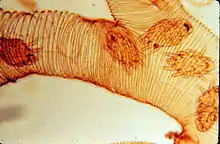Acarapis woodi
Acarapis woodi is an internal parasite affecting honey bees,[1] the symptoms of infestation was originally observed on the Isle of Wight in 1904,[2] but was not described until 1921.[3] Acarapis woodi mites live and reproduce in the tracheae of the bees. The symptoms of Acarapis woodi infestation were originally called by beekeepers as the Isle of Wight Disease, however it is now called Acarine, after the Subclass to which the mites belong. All mites are arachnids like spiders.[3] The female mite attaches 5–7 eggs to the tracheal walls, where the larvae hatch and develop in 11–15 days to adult mites.[3] The mites parasitize young bees up to two weeks old through the tracheal tube openings. There, they pierce the tracheal tube walls with their mouthparts and feed on the haemolymph of the bees. More than a hundred mites can populate the tracheae and weaken the bees. The mites are generally less than 175 micrometres (0.007 in) long, and can only be seen and identified under a microscope.[3]
| Acarapis woodi | |
|---|---|
 | |
| Scientific classification | |
| Kingdom: | Animalia |
| Phylum: | Arthropoda |
| Subphylum: | Chelicerata |
| Class: | Arachnida |
| Subclass: | Acari |
| Order: | Trombidiformes |
| Family: | Tarsonemidae |
| Genus: | Acarapis |
| Species: | A. woodi |
| Binomial name | |
| Acarapis woodi (Rennie, 1921) | |
Other mites similar in appearance include Acarapis externus and Acarapis dorsalis.
References
- ""Tracheal mites" Tarsonemidae". Agricultural Research Service, United States Department of Agriculture. February 18, 2005. Archived from the original on May 17, 2011. Retrieved March 10, 2011.
- Anderson, John; Rennie, John (1916). Observations and experiments bearing on the "Island of Wight" disease. Proceedings of the Royal Physical Society of Edinburgh ;v. 20, pt. 1. Edinburgh: R. Grant & Son.
- H. A. Denmark, H. L. Cromroy & Malcolm T. Sanford (2000). "Honey bee tracheal mite, Acarapis woodi". Featured Creatures. University of Florida. Retrieved March 10, 2011.